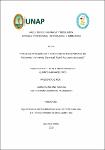Tamizaje fitoquímico y actividad antibacteriana de Alchornea triplinervia (Sprengel) Muell Arg (zancudo caspi)

View/
Date
2022Author
Melena Vargas, Carmina
Moreno Fasanando, Saly Giovanna
Metadata
Show full item recordAbstract
Worldwide, bacterial resistance is a public health problem, being one of the main causes of therapeutic failure in infectious diseases. The objective of the present study was to determine the in vitro antibacterial activity of Alchornea triplinervia (Sprengel) Muell Arg "zancudo caspi" against Staphylococcus aureus ATCC 25923, Pseudomonas aeruginosa ATCC 27853 and Escherichia coli ATCC 25922 and clinical isolates, and to identify the secondary metabolites in leaves and bark, through phytochemical screening. For phytochemical screening, the method of Chhabra, et al. Adapted and for antibacterial activity, the Disc Diffusion method (Kirby-Bauer) and CMI. The yield obtained was: leaf 11.88% and bark 3.22%. In the phytochemical screening, the presence of phenols, tannins, flavonoids, steroidal triterpenes and saponins was found; In the antibacterial activity according to the inhibition halo, the leaf extract presented an inhibition halo of 12 mm at 125 mg/mL and the bark 11 mm at 62.5 mg/mL, against S. aureus. Ampicillin, penicillin and oxacillin were used as positive control and ethanol as negative control. It is concluded that this plant species shows an abundant presence of flavonoids, phenols, tannins and a low amount of steroidal triterpenes and saponins. According to the inhibition halo obtained against S. aureus, this activity is considered to be intermediate and according to the minimum inhibitory concentration (MIC) it is inactive; likewise, the leaves and bark of A. triplinervia are inactive against P. aeruginosa and E. coli. A nivel mundial la resistencia bacteriana es un problema de salud pública, siendo una de las principales causas de fracasos terapéuticos en las enfermedades infecciosas. El objetivo del presente estudio fue determinar la actividad antibacteriana in vitro de Alchornea triplinervia (Sprengel) Muell Arg “zancudo caspi” frente a Staphylococcus aureus ATCC 25923, Pseudomona aeruginosa ATCC 27853 y Escherichia coli ATCC 25922 y aislados clínicos, e identificar los metabolitos secundarios en hojas y corteza, mediante tamizaje fitoquimico. Para el tamizaje fitoquímico, se utilizó el método de Chhabra, et al. Adaptado y para la actividad antibacteriana, el método de Disco Difusión (Kirby-Bauer) y CMI. El rendimiento obtenido fue: hoja 11,88% y corteza 3,22%. En el tamizaje fitoquímico se encontró presencia de fenoles, taninos, flavonoides, triterpenos esteroides y saponinas; en la actividad antibacteriana de acuerdo al halo de inhibición el extracto de hojas presentó un halo de inhibición de 12 mm a 125 mg/mL y la corteza 11mm a 62,5 mg/mL. frente a S. aureus. Como control positivo se utilizó ampicilina, penicilina y oxacilina y como control negativo etanol. Se concluye que esta especie vegetal muestra abundante presencia de flavonoides, fenoles, taninos y escasa cantidad de triterpenos esteroides y saponinas. De acuerdo al halo de inhibición obtenido frente a S. aureus, se considera que esta actividad es resistente y según la concentración mínima inhibitoria (CMI) es inactivo; asimismo, las hojas y corteza de A. triplinervia son inactivos frente a P. aeruginosa y E. coli.
Collections
- Tesis [295]

